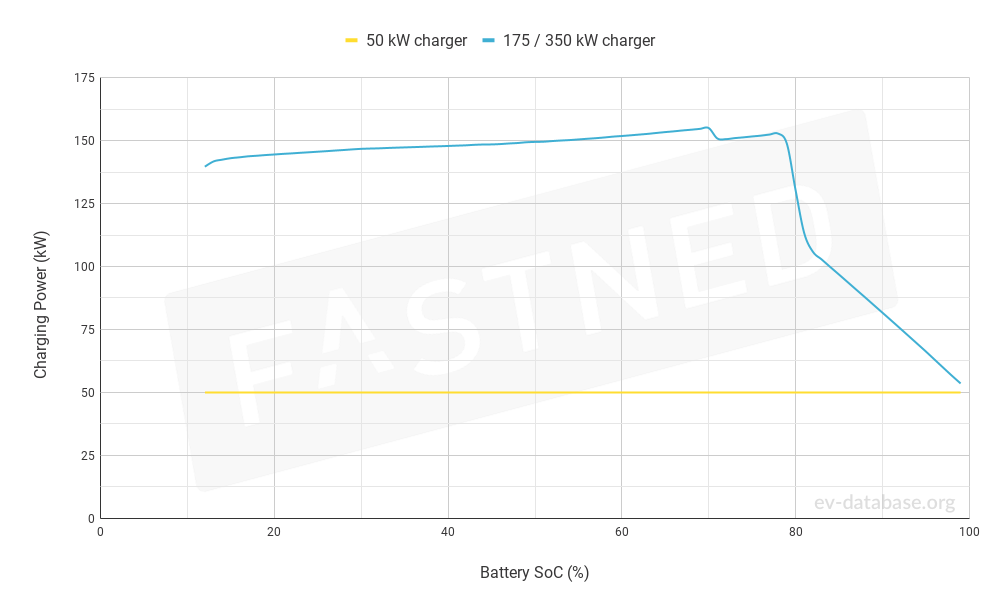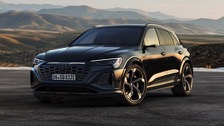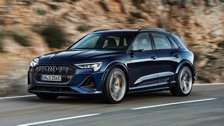Audi e-tron S
October 2021 - September 2022£88,435Price from
86.5 kWhUseable Battery
195 miReal Range
444 Wh/miEfficiency
This electric vehicle is no longer for sale
A new model is available: orcheck out the full archive here
Price from (last known) £88,435
| Availability | Not available to order |
| Available to order from | October 2021 |
| Available to order until | September 2022 |
| Annual VED | £0 |
| Congestion Charge | £0 |
| Insurance Group | 50 |
Real Range between 140 - 275 mi
| City - Cold Weather | 200 mi |
| Highway - Cold Weather | 140 mi |
| Combined - Cold Weather | 170 mi |
| City - Mild Weather | 275 mi |
| Highway - Mild Weather | 175 mi |
| Combined - Mild Weather | 220 mi |
Performance
| Acceleration 0 - 62 mph | 4.5 sec |
| Top Speed | 130 mph |
| Electric Range | 195 mi |
| Total Power | 370 kW (496 hp) |
| Total Torque | 718 lb-ft |
| Drive | AWD |
Battery
| Nominal Capacity | 95.0 kWh |
| Battery Type | Lithium-ion |
| Number of Cells | 432 |
| Architecture | 400 V |
| Warranty Period | No Data |
| Warranty Mileage | No Data |
| Useable Capacity | 86.5 kWh |
| Cathode Material | NCM622 |
| Pack Configuration | 108s4p |
| Nominal Voltage | 400 V |
| Form Factor | No Data |
| Name / Reference | No Data |
Charging
Home / Destination
| Charge Port | Type 2 |
| Port Location | Right Side - Front |
| Port Location 2 | Left Side - Front |
| Charge Power † | 22 kW AC |
| Charge Time (0->195 mi) † | 4h45m |
| Charge Speed † | 42 mph |
Rapid Charging
| Fastcharge Port | CCS |
| FC Port Location | Right Side - Front |
| Fastcharge Power (max) | 155 kW DC |
| Fastcharge Power (10-80%) | 146 kW DC |
| Fastcharge Time (19->156 mi) | 26 min |
| Fastcharge Speed | 310 mph |
| Autocharge Supported | No |
Plug & Charge
| Plug & Charge Supported | No |
| Supported Protocol | - |
Bidirectional Charging (V2X / BPT)
Vehicle-to-Load (V2L)
| V2L Supported | No |
| Max. Output Power | - |
| Exterior Outlet(s) | - |
| Interior Outlet(s) | - |
Vehicle-to-Home (V2H)
| V2H via AC Supported | No |
| Max. Output Power | - |
| V2H via DC Supported | No |
| Max. Output Power | - |
Vehicle-to-Grid (V2G)
| V2G via AC Supported | No |
| Max. Output Power | - |
| V2G via DC Supported | No |
| Max. Output Power | - |
Energy Consumption
EVDB Real Range
| Range | 195 mi |
| Vehicle Consumption | 444 Wh/mi |
| CO2 Emissions | 0 g/km |
| Vehicle Fuel Equivalent | 91 mpg |
WLTP Ratings (TEL)
| Range | 232 mi |
| Rated Consumption | 420 Wh/mi |
| Vehicle Consumption | 372 Wh/mi |
| CO2 Emissions | 0 g/km |
| Rated Fuel Equivalent | 96 mpg |
| Vehicle Fuel Equivalent | 109 mpg |
WLTP Ratings (TEH)
| Range | 213 mi |
| Rated Consumption | 457 Wh/mi |
| Vehicle Consumption | 406 Wh/mi |
| CO2 Emissions | 0 g/km |
| Rated Fuel Equivalent | 89 mpg |
| Vehicle Fuel Equivalent | 100 mpg |
Rated = official figures as published by manufacturer. Rated consumption and fuel equivalency figures include charging losses.
Vehicle = calculated battery energy consumption used by the vehicle for propulsion and on-board systems.
NOTE: The fuel equivalency figures are shown in IMPERIAL MPG. Figures in US MPG will differ significantly.
Real Energy Consumption between 315 - 618 Wh/mi
| City - Cold Weather | 433 Wh/mi |
| Highway - Cold Weather | 618 Wh/mi |
| Combined - Cold Weather | 509 Wh/mi |
| City - Mild Weather | 315 Wh/mi |
| Highway - Mild Weather | 494 Wh/mi |
| Combined - Mild Weather | 393 Wh/mi |
Dimensions and Weight
| Length | 4902 mm |
| Width | 1976 mm |
| Width with mirrors | 2043 mm |
| Height | 1629 mm |
| Wheelbase | 2928 mm |
| Weight Unladen (EU) | 2730 kg |
| Gross Vehicle Weight (GVWR) | 3280 kg |
| Max. Payload | 625 kg |
| Cargo Volume | 660 L |
| Cargo Volume Max | 1655 L |
| Cargo Volume Frunk | No Data |
| Roof Load | 75 kg |
| Tow Hitch Possible | Yes |
| Towing Weight Unbraked | 750 kg |
| Towing Weight Braked | 1800 kg |
| Vertical Load Max | 80 kg |
Miscellaneous
| Seats | 5 people |
| Isofix | Yes, 3 seats |
| Turning Circle | 12.2 m |
| Platform | VW MLB |
| EV Dedicated Platform | No |
| Car Body | SUV |
| Segment | Executive |
| Roof Rails | Yes |
| Heat pump (HP) | Yes |
| HP Standard Equipment | Yes |
Company Car Tax Indication
Financial Year 2021-22
| BIK Tax Rate | 1% |
| P11D Value from | £88,380 |
| Benefit in Kind (BIK) | £884 |
| BIK @ 20% | £15 pcm |
| BIK @ 40% | £29 pcm |
| BIK @ 45% | £33 pcm |
Financial Year 2022-23
| BIK Tax Rate | 2% |
| P11D Value from | £88,380 |
| Benefit in Kind (BIK) | £1,768 |
| BIK @ 20% | £29 pcm |
| BIK @ 40% | £59 pcm |
| BIK @ 45% | £66 pcm |
Financial Year 2023-24
| BIK Tax Rate | 2% |
| P11D Value from | £88,380 |
| Benefit in Kind (BIK) | £1,768 |
| BIK @ 20% | £29 pcm |
| BIK @ 40% | £59 pcm |
| BIK @ 45% | £66 pcm |
Home and Destination Charging (0 -> 100%)
Charging is possible by using a regular wall plug or a charging station. Public charging is always done through a charging station. How fast the EV can charge depends on the charging station (EVSE) used and the maximum charging capacity of the EV. The table below shows all possible options for charging the Audi e-tron S. Each option shows how fast the battery can be charged from empty to full.
| Type 2 (Mennekes - IEC 62196) |
|---|
 |
| Charging Point | Max. Power | Power | Time | Rate |
|---|---|---|---|---|
| Wall Plug (2.3 kW) | 230V / 1x10A | 2.3 kW | 44h15m | 4 mph |
| 1-phase 16A (3.7 kW) | 230V / 1x16A | 3.7 kW | 27h30m | 7 mph |
| 1-phase 32A (7.4 kW) | 230V / 1x32A | 7.4 kW | 13h45m | 14 mph |
| 3-phase 16A (11 kW) | 400V / 3x16A | 11 kW | 9h15m | 21 mph |
| 3-phase 32A (22 kW) | 400V / 3x32A | 22 kW † | 4h45m | 41 mph |
† = Limited by on-board charger, vehicle cannot charge faster.
Rapid Charging (10 -> 80%)
Rapid charging enables longer journeys by adding as much range as possible in the shortest amount of time. Charging power will decrease significantly after 80% state-of-charge has been reached. A typical rapid charge therefore rarely exceeds 80% SoC. The rapid charge rate of an EV depends on the charger used and the maximum charging power the EV can handle. The table below shows all details for rapid charging the Audi e-tron S.
Read more about rapid charging of the Audi e-tron S on the Fastned website.
- Max. Power: maximum power provided by charge point
- Avg. Power: average power provided by charge point over a session from 10% to 80%
- Time: time needed to charge from 10% to 80%
- Rate: average charging speed over a session from 10% to 80%
| Combined Charging System (CCS Combo 2) |
|---|
 |
| Charging Point | Max. Power | Avg. Power | Time | Rate |
|---|---|---|---|---|
| CCS (50 kW DC) | 50 kW | 50 kW | 76 min | 100 mph |
| CCS (175 kW DC) | 155 kW † | 146 kW † | 26 min | 310 mph |
| CCS (350 kW DC) | 155 kW † | 146 kW † | 26 min | 310 mph |
| Charge Curve |
|---|

|
|
Data made available by Fastned |
| This vehicle does not support Autocharge |
|---|
| This vehicle does not support Plug & Charge |
† = Limited by charging capabilities of vehicle
Autocharge: allows for automatic initiation of a charging session at supported CCS charging stations.
Plug & Charge: allows for automatic initiation of a charging session at supported CCS charging stations in accordance with ISO 15118.
Actual charging rates may differ from data shown due to factors like outside temperature, state of the battery and driving style.
All about the Audi e-tron S
No longer available
This electric vehicle is no longer in production and not available to buy new. The Audi e-tron S was available from October 2021 until September 2022. Financial data like price, leasing and company car tax were applicable to the final year of availability of the Audi e-tron S.
A new model of the Audi e-tron S (2021) is available: Audi SQ8 e-tron (2023).
Pricing
The Audi e-tron S had a Recommend Retail Price (RRP) of £87,720 and an On The Road Price (OTR) of £88,435. The OTR Price includes VAT, first year of VED, vehicle first registration fee, number plates and delivery.
Drivetrain and Performance
The Audi e-tron S is a full electric vehicle (BEV). The maximum power of the Audi e-tron S is 370 kW (496 hp). The maximum torque is 718 lb-ft. The Audi e-tron S is all wheel drive and can accelerate from 0 to 62 miles per hour in 4.5 seconds. The top speed is 130 mph.
Battery and Charging
The battery of the Audi e-tron S has a total capacity of 95 kWh. The usable capacity is 86.5 kWh. A range of about 195 miles is achievable on a fully charged battery. The actual range will however depend on several factors including climate, terrain, use of climate control systems and driving style.
For example: sustaining high speeds in cold weather could result in a range of around 140 mi. However, driving at low speeds in mild weather will increase the range to around 275 mi.
Charging is done using a Type 2 connector and the on-board charger has a maximum power of 22 kW. This charges a fully depleted battery back to full in around 4 hours 45 minutes. However, a 3-phase grid connection is needed to achieve this. The majority of homes and charge points currently do not have this connection. In most cases the maximum charging power will be 7.4 kW, allowing for a charge time of 13 hours 45 minutes and a charge rate of 14 mph. Charging the car using a regular wall plug will take around 44 hours 15 minutes.
Rapid charging is possible through a CCS connection. The maximum rapid charge power is 155 kW. The battery can't be charged continuously at this power. In an average rapid charge session the average charge power will be around 146 kW. This charges the battery from 10% to 80% in around 30 minutes. A rapid charge like this will add about 135 miles of range.
Energy Consumption
The combined (motorway and city) energy consumption of the Audi e-tron S is about 444 Wh per mile. By comparison, this energy consumption is the equivalent of a fuel consumption of 91 mpg in a traditional petrol car.
The actual energy consumption will depend on several factors including climate, terrain, use of climate control systems and driving style. For example: sustaining high speeds in cold weather could result in an energy use of around 618 Wh per mile. However, driving at low speeds in mild weather will increase the efficiency to about 315 Wh per mile.
CO2 Emission
The Audi e-tron S emits no CO2 during driving. This only includes direct emissions from the vehicle itself. The energy needed to charge the battery might have been (partly) generated by the use of fossil fuels. Vehicles with an internal combustion engine will always emit CO2 during driving. Additionally, CO2 is emitted during the production and transport of fossil fuels.
More information from Audi
The link below will open the page of the e-tron S on the official Audi site.
Preceding model
The model shown on this page is the successor of the Audi e-tron S, which was available to order from October 2020 until September 2021. The previous model was £1435 less expensive, had 5 mi more range, same acceleration and was similar in energy consumption.

 Audi SQ8 e-tron
Audi SQ8 e-tron Preceding model Audi e-tron S
Preceding model Audi e-tron S